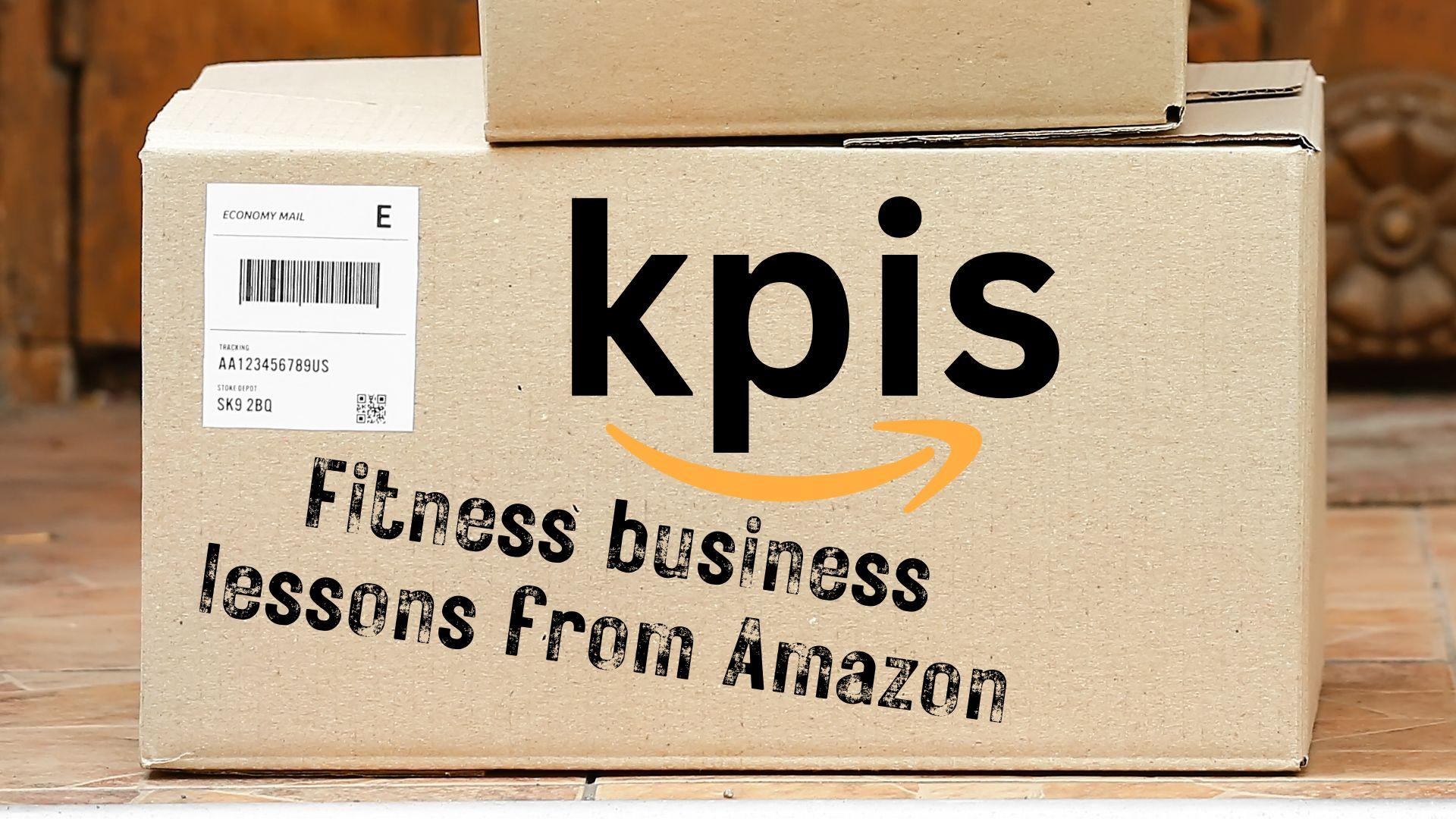Introduction to KPIs:
The most important six hours I spend in my business every year, are the 30 minutes a month where I do a deep dive into my KPIs.
KPIs, or ‘Key Performance Indicators’ are the numbers that tell you how well your business is going. And I’d like to tell you about the most important 12 numbers that a fitness professional should be tracking.
And KPIs aren’t just for fitness professionals. Let’s look at the story of Amazon.
Lessons from Amazon:
When Jeff Bezos founded Amazon, he faced a big challenge. The company had a massive inventory, making it hard for customers to find what they needed. Bezos realised that to improve Amazon, he needed to use customer data to make shopping more personal.
Bezos decided to focus on data analytics. Just like in a fitness business, his goal was to understand customer behaviour. This meant developing algorithms to look at what customers bought, what they searched for, and how they browsed.
The task was to identify the right Key Performance Indicators to track customer preferences. This involved analysing purchase frequencies, average order values, and how often customers clicked on product recommendations.
This focus on data led to Amazon’s recommendation system. It started giving customers personalised suggestions, making shopping easier. The system also helped Amazon predict which products would be popular and manage inventory better.
Jeff Bezos’s decision to use data analytics changed Amazon. It solved the problem of helping customers find products and set a new standard in online shopping. This approach made Amazon more customer-focused and efficient, showing Bezos’s understanding of the importance of data in e-commerce.
I simply cannot overstate enough how important this is if you want to run a professional, successful business. Avoid KPIs at your own risk.
While we might not be operating at the scale of Amazon, there’s a lot we can learn from this story.
The most important thing
I’m going to write this in capital letters! YOUR BUSINESS EXISTS TO MAKE YOUR LIFE BETTER. YOU LIFE DOESN’T EXIST TO MAKE YOUR BUSINESS BETTER.
Read that again!
You shouldn’t work on your KPIs until you’ve first designed the life that you want your business to provide you.
Design your perfect day, week, month and year. Work out how much money and time each element of your perfect life will cost.
How much money do you need to live that life? That’s how much your target KPIs need to earn you.
How much time do you need to live that life? The remainder is the amount of time in which you have to earn the money you need to live that life.
KPIs are a means to an end. Your business is the means, your life is the end.
The Process of Tracking KPIs:
At the start of each month, I sit down and do a deep dive into the previous month’s numbers. For me, these numbers come from my calendar, from my bank account, from my accounting software (I use Xero) and from various spreadsheet I use to track various metrics.
Here’s an important point. I intentionally DON’T try to over automate this process. I don’t want the numbers to be magically pulled into a spreadsheet from some other source without me having to do any work to find them. The process of searching for the data and calculating numbers is one of the most important parts of this exercise. It allows me to really understand them – not just the end result, but the process it takes to get there. Because of this, I understand the inner workings of my business, and how the things I do equate to real life results and returns. Systems and delegation are great, but for KPIs I don’t want either. This is my opportunity to get intimate with my business.
I’ve mentored business owners who don’t track any numbers in their business. It’s no coincidence that these are the same people who feel overwhelmed and directionless.
Before we jump into the exact KPIs you should be tracking, let’s talk about the four ways your business will be advantaged if you do track them.
The Benefits of Tracking KPIs:
Firstly, it allows you to spot trends in the direction your business is heading. Positive trends in the numbers provide reassurance that you’re on the right track and should persist with any current business strategies. Maybe you’ve launched a new marketing campaign, and leads are increasing. It tells you that yes, the campaign is effective and you should not only continue, but maybe double-down on this investment. Negative trends can be a sign that something needs to change – and often, the numbers can be an early warning that the bottom line will be affected in the near future. Maybe you’ve changed your timetable, and attendance rates have dropped. Being aware of this may cause you to reconsider the change.
Secondly, tracking KPIs allows you to find patterns and correlations between the actions you are completing within your business, and how they transfer to the bottom line. This bottom line will be a lagging indicator of the success of the actions and behaviours you’re undertaking. Has your profit increased even though client numbers have stayed the same? Your recent price increase had the desired effect.
Thirdly, tracking your KPIs reduces the anxiety that can come from a bad patch of business. Maybe it’s school holidays and a lot of your clients are away. Revenue drops and you start to panic. Is this the beginning of the end for your business? Having historical KPI data will allow you to look back to the same time last year and realise that this seasonality is consistent. Your business isn’t dying, it’s just a predictable and expected dip that you’ll quickly recover from.
The final benefit of tracking KPIs is that it allows you to identify bright spots (things you’re doing well), and opportunities (things you could be doing better). With this information, you can double down on the things you’re doing well, and address those that you’re not.
Let me take you through the process I use in my own business and the businesses of the owners I mentor, then I’ll give you the KPIs you need to be tracking.
The KPI Spreadsheet:
I have a simple spreadsheet.
In column A is the actual metric, the KPI, that I want to track. These are the things I’ll cover soon.
Column B is my yearly target, the number I want to achieve this financial year.
Then column C is the actual results from the most recent month. In columns D, E, F etc. I have the previous month’s numbers. I have the months going backward, that is, the most recent month on the left, so the most recent data is always the most visible.
The spreadsheet is then colour coded based on how close to each target my current KPIs are.
For example, if a gym wants to have 150 members, and they’re currently at 145, I would have that row shaded in green. Green means we’ve already achieved the target, or are very close.
If personal trainer wants to be doing 80 sessions a month, and they currently do 60, I would shade that row in orange.
And if a business wanted to generate $30,000 in revenue per month, and they were currently sitting at $10,000, I would highlight that in red.
The colours give a strong visual representation of where the focus of the business owner needs to be. Most of their time should be spent working on red tasks – that’s the low hanging fruit that can give the greatest return on your work. Some time should be spent on orange tasks, and very little time should be spent on green tasks which are already close to the target number.
As you improve on your KPIs, you’ll update the colour coding so you’ve always got a rolling indication of where your resources should be spent.
Alright, let’s get into the numbers you should be tracking.
The KPIs to Track:
This isn’t an exhaustive list, but these are the numbers I think are most important.
We start with the number of new leads. Tracking the number of all new enquiries is one of the best measures of the success of your external marketing (including brand awareness). Finding relationships between your new enquires and your marketing efforts will help direct your marketing.
This will lead to our next KPI, new paying clients. While new leads are an effective way of identifying all enquires, you should also measure all new paying clients. Looking at the percentage of all new leads who become paying clients is a valuable way to measure the success of the initial steps of your client journey. If you have a lot of leads, but the conversion to paying clients is low, either your marketing is directed towards the wrong sort of person, or the initial experience your prospects are receiving needs work.
At the other end of the client journey, client departures. New leads and new clients are worth little if they don’t hang around. You should not only track the number of client departures, but also the reasons for each departure. While new leads tell you about your external marketing, and new paying clients tell you about the success of your sales process, client departures tell you how much value you’re providing and how good the experience is. This is possibly the most important KPI to tell you how good you are at doing what you promise.
Client departures leads us to retention of existing clients. This number will tell you how many of last month’s clients are still with you this month, giving you a retention rate. To calculate this number, use the equation: ((number of active clients last month – number of client departures this month)/number of active clients last month)*100). This gives you a percentage of last month’s clients who are still clients this month, without the data being clouded by any new clients.
It’s also important to track active clients. A great KPI to track the long term trending of your business, active clients are your current total paying clients. This number encapsulates both new paying clients and client departures. An positive upwards trend (increase in active clients) is a great indicator of business growth.
If you have multiple services you’re providing, like Personal Training, Gym Memberships, Semi Private Training and Nutrition Coaching, you should also track the number of active clients for each of these services.
Now we move to some of the financial numbers in your business, and you can see each of the KPIs we’ve already discussed will contribute to your financial metrics. Dollars are secondary to these more primary KPIs.
We can broadly categories financial metrics into revenue, how much money is coming in to your business, expenditure, how much money is leaving your business, and profit, which is revenue minus expenditure. If you have multiple services you’re providing, you can also break down revenue and profit for each of the different services.
With the business owners I mentor, this information is valuable when we run and 80/20 analysis to determine which 20% of the work is resulting in 80% of the profit. It’s a vital step in running a business with efficient profit generation.
I take these financial metrics directly from my accounting software.
Based on the KPIs we’ve already touched on, you can then calculate average revenue per client. Which is simply revenue divided by number of clients. The higher this is, the more value your clients are receiving, because people pay more when you provide a better experience when you provide more value, and when you do a better job of solving their problems.
While we’re discussing finances, I’ve got a few KPIs that deserve a ‘special mention’. Personally, I remove most of the monthly profits from my business as my monthly salary. So, on paper, the monthly profit of the business is usually zero. To make this number more realistic, I also track monthly profit before owner drawings. This allows me to get a more accurate look at the capacity of the business to generate me income. I’ll also track profit after tax, because ultimately, I want to know how much money I’m taking home.
There are three KPIs that I track that are a bit non-traditional.
The first is total hours worked. Every day, I track my time across seven categories, which are then added together to give total work time for that day. There’s no point earning lots of money if I have to work 70 hours a week to do it. At the end of each month I record total hours worked as a KPI.
This number allows me to calculate the next metric, profit per hour after tax. I take my monthly profit after tax, and divide it by the number of hours I’ve worked. This tells me how valuable my time is. Increasing this number means I’m being more efficient at making money.
The final non-traditional KPI I track is a satisfaction with life scale. I consider five statements, and rate the accuracy of each on a scale of one to seven. The statements are:
- In most ways, my life is close to my ideal.
- The conditions of my life are excellent.
- I am satisfied with my life.
- So far, I have gotten the important things I want in life.
- If I could live my life over, I would change almost nothing.
These five scores are added together to give me a satisfaction with life out of 35.
This is my most important KPI, because my business exists to make my life better. If my profit is high, but my satisfaction with life scale is low, I’ve seriously dropped the ball somewhere. Chances are, I’ve gotten too caught up in the business, and lost sight of the reason the business exists.
So let’s list those KPIs you should be tracking:
- Number of new leads.
- New paying clients.
- Client departures.
- Retention of existing clients.
- Active clients.
- Revenue.
- Expenditure.
- Profit.
- Average revenue per client.
- Total hours worked.
- Profit per hour after tax.
- Satisfaction with life scale.
Consistently monitoring your KPIs is essential for running a successful fitness business. By regularly reviewing these key metrics, you ensure your business stays on track, making informed decisions that lead to growth and improved performance.





